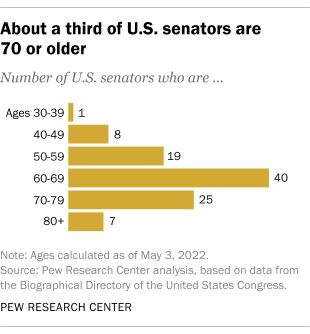This year, as in every even-numbered year, about a third of U.S. Senate seats will be up for election. Given the 50-50 split in the Senate between Democrats and Republicans, each of those races has the potential to tip the chamber’s balance of power one way or the other. But elections aren’t the only way that can happen.
In the event that a sitting senator resigns or dies, or the position otherwise becomes vacant, governors in 46 states have the power to appoint a temporary replacement. And in most of those states, governors have free rein to appoint whomever they wish, with the appointee serving until a successor is elected to fill out the rest of the term. The evenly split Senate means that even a single governor could, hypothetically, determine which party controls the chamber.
We compiled information on state procedures for filling U.S. Senate vacancies from each state’s online code of state law. Data on senators’ birthdays, which we used to calculate their ages, and length of service come from the Biographical Directory of the United States Congress.

The possibility of appointed senators tipping the partisan balance, or at least giving an electoral advantage to one party or the other, is brought into sharper relief when one considers that this is the oldest Senate in American history. The mean age of U.S. senators, as of May 3, 2022, is now 65.1. A quarter of senators (25) are in their 70s, and seven are in their 80s; the latter group includes Iowa Republican Chuck Grassley, who is 88 and running for an eighth term this year, and California Democrat Dianne Feinstein, who will turn 89 in June and is the chamber’s oldest current member.
Feinstein has been the subject of recent reporting in which some of her Senate colleagues have raised concerns about her cognitive abilities and fitness to continue serving. Feinstein, who has served in the Senate for almost 30 years, has insisted that she can still effectively represent her state.
Feinstein’s current term isn’t up until 2024, so should her seat become vacant before then, it would be up to Gov. Gavin Newsom, a fellow Democrat, to appoint a temporary replacement. Newsom, like most governors, would have no restrictions on whom he could appoint – other than the constitutional age, citizenship and residency requirements that apply to all senators.
The current system for filling vacant Senate seats dates to the ratification of the 17th Amendment in 1913. Along with letting people elect their senators directly – state legislatures had chosen them up to that point – the amendment gave states the option of letting their governors appoint temporary replacements. The only states not to do so are North Dakota, Oregon, Rhode Island and Wisconsin; in those states, vacancies can only be filled by special election.

Among the 46 states that do give their governors authority to name replacement senators, 11 limit their field of choice in some way. Seven states – Hawaii, Kentucky, Maryland, Montana, North Carolina, West Virginia and Wyoming – make the governor choose from a list of nominees submitted by the previous senator’s party. (Kentucky joined that group last year, at the urging of Republican Sen. Mitch McConnell, age 80; perhaps coincidentally, Kentucky Gov. Andy Beshear is a Democrat.) Utah requires the governor to choose from a list of candidates compiled by the legislature, all of whom must be of the same party as the previous senator. Arizona and Oklahoma simply require the governor to choose someone from the previous senator’s party.
Connecticut has the most restrictive rules: The governor can fill a Senate vacancy only if there’s a year or less remaining in the term, and his or her choice must be approved by a two-thirds vote in each house of the state legislature.
The 17th Amendment also gives states considerable leeway in deciding how long temporary senators can serve until a special election. In 30 states, special Senate elections must be held concurrently with regular general elections. In some cases, those special elections coincide with the next scheduled general election, but in other cases – especially if the vacancy occurs late in the election cycle – they coincide with the general election after the next one.
Five states have specific timetables for holding special Senate elections, usually a certain number of days following the occurrence of the vacancy. Thirteen states authorize either a separate date for the special election or hold it concurrently with the next general election, depending on when the vacancy occurs. And two states have few or no rules on when a special election must be held, effectively leaving the decision up to the governor.
Oklahoma is holding a special election this year for a vacancy that hasn’t even occurred yet. Republican Sen. James Inhofe, 87, has indicated that he will resign at the end of the current Congress, and Gov. Kevin Stitt (a fellow Republican) has scheduled a special election to fill the remaining four years of Inhofe’s term. Such a preemptive election is legal under state law, though a prominent Oklahoma lawyer is challenging its constitutionality.
Two other senators in the 80-plus club, Alabama Republican Richard Shelby (age 87) and Vermont Democrat Patrick Leahy (82), are retiring at the end of their terms this year. The terms of the other two older senators, McConnell and Vermont independent Bernie Sanders – who caucuses with the Democrats – don’t expire until 2026 and 2024, respectively. Both men are 80.



